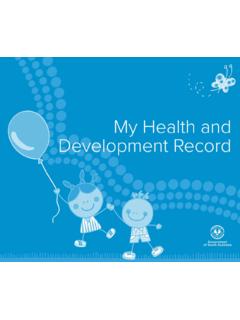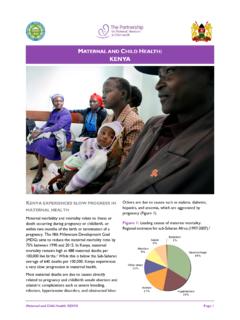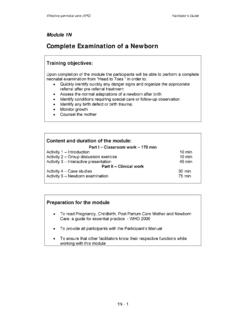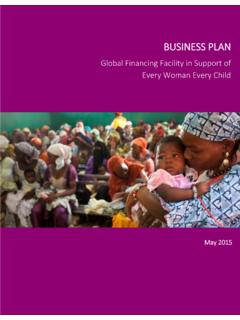Transcription of Counselling for Maternal and Newborn Health - …
1 A handbook for building skills Counselling for Maternal and Newborn Health Adaptation Guide Updated 2014 WHO Adaptation Guide for MNH Counselling Handbook iTABLE OF CONTENTS ACKNOWLEDGEMENTS .. III ABBREVIATIONS .. IV 1. INTRODUCTION .. 1 2. ABOUT THE MNH Counselling HANDBOOK .. 2 BACKGROUND .. 2 2 CONTENT .. 3 KEY PRINCIPLES .. 4 INTENDED USERS .. 5 3. ADAPTATION PROCESS .. 5 ASSESSING THE NEED TO ADAPT .. 5 PROCESS OF ADAPTATION .. 6 Appoint an Adaptation Committee .. 7 Develop the Terms of Reference .. 7 Review the MNH Counselling Handbook .. 7 Adaptation .. 8 Align with National Policies .. 9 4. TRANSLATION .. 9 5. SUGGESTED ADAPTATIONS .. 9 LINKS WITH PCPNC .. 9 CONSIDERATIONS FOR ADAPTATION .. 11 CULTURAL CONSIDERATIONS .. 12 Counselling Skills (Session 3) ..12 Factors influencing the Counselling Session (Session 4) ..12 Support during Labour and Childbirth (Session 10) ..13 Death and Bereavement (Session15).
2 14 ILLUSTRATIONS .. 14 LOCAL TERMINOLOGY AND CONCEPTS .. 15 LEGAL, HUMAN AND REPRODUCTIVE Post-Abortion Care (Session 9) ..16 Women and Violence (Session 16) ..16 CONSISTENCY WITH NATIONAL PROTOCOLS AND GUIDELINES .. 16 Counselling Paradigms (Sessions 2-5) ..17 General Care (Session 6) ..17 Birth and Emergency Planning (Session 7) ..17 Family Planning Counselling (Session 12) ..18 Breastfeeding (Session 13) ..18 Women with HIV/AIDS (Session 14) ..19 PRIORITY Maternal AND Newborn Health ISSUES NOT ADDRESSED .. 19 Female Genital Mutilation (FGM) ..19 Obstetric Fistulae ..20 Malaria ..20 Adolescents and Women with Special Needs ..21 6. BUILDING CONSENSUS FOR ADAPTATION ..22 7. FIELD TESTING ..22 WHO Adaptation Guide for MNH Counselling Handbook ii8. IMPLEMENTATION ..23 9. MONITORING AND EVALUATION ..25 10. ADAPTATION BIBLIOGRAPHY ..27 11. REFERENCES ..27 ANNEX 1 ..29 ANNEX 2 ..36 ANNEX 3 ..46 BOX 1 MNH Counselling HANDBOOK'S OBJECTIVES.
3 1 BOX 2 MNH Counselling HANDBOOK'S TOPICS .. 3 BOX 3 TRANSLATION TIPS .. 9 TABLE 1 PCPNC LINKS TO ADAPTATION GUIDE & MNH Counselling HANDBOOK .. 10 TABLE 2 SUMMARY TABLE: CONSIDERATIONS FOR ADAPTATION .. 11 TABLE 3 POTENTIAL LANGUAGE BARRIERS .. 15 TABLE 4 EVALUATING THE MNH Counselling HANDBOOK .. 26 FIGURE 1 SCHEMATIC OVERVIEW OF THE Counselling PROCESS .. 4 FIGURE 2 FLOW DIAGRAM: SUGGESTED ADAPTATION 6 WHO Adaptation Guide for MNH Counselling Handbook iii Acknowledgements This Adaptation Guide for " Counselling for Maternal and Newborn Health : A handbook for building skills" was written by Hannah Ashwood-Smith, with technical support from Annie Portela (World Health Organization Department of Maternal , Newborn , Child and Adolescent Health (WHO/MCA). The Guide was updated in 2014, by Pooja Pradeep, intern to WHO/MCA, to reflect the updates made to the MNH Counselling Handbook. Valuable inputs were received from Yolande Coombes, independent consultant and Margareta Larsson, Ornella Lincetto, Matthews Matthai, Juliana Yartey, and Jelka Zupan of WHO/MCA.)
4 In addition, Heather Brown provided input on the sections about sexuality, and Nasr Abdallah of Sudan provided comments regarding cultural considerations. The first draft was edited by Pat Coppard and Barbara Ashwood-Smith. The final draft was edited by Annie Portela and Karen Mulweye, WHO/MCA. MCA/WHO gratefully acknowledges the contribution of the teams who conducted the field reviews for the " Counselling for Maternal and Newborn Health : A handbook for building skills" (MNH Counselling Handbook) in Malawi, Indonesia, Sudan and the Philippines. Many of the suggested recommendations in this document draw from this body of work. The enthusiasm, motivation and commitment of the Skilled Attendants interviewed were paramount to the development of the MNH Counselling Handbook and to this technical adaptation guide. WHO Adaptation Guide for MNH Counselling Handbook ivAbbreviations AIDS Acquired immunodeficiency syndrome ANC Antenatal care ARV Antiretroviral drug BEOC Basic emergency obstetric care CEOC Comprehensive emergency obstetric care FGM Female genital mutilation FP Family Planning HIV Human immunodeficiency virus IEC Information, education and communication department IUD Intrauterine Device LAM Lactational Amenorrhoea Method MCA Maternal , Newborn , Child and Adolescent Health MCH Maternal and child Health MNH Maternal and Newborn Health PCPNC Pregnancy, Childbirth, Postpartum and Newborn Care.
5 A Guide for Essential Practice PLPWA People Living Positively with AIDS PMTCT Prevention of mother-to-child transmission SAs Skilled Attendants STIs Sexually transmitted infection TB Tuberculosis TBAs Traditional Birth Attendants WHO World Health Organization WHO Adaptation Guide for MNH Counselling Handbook 11. Introduction The World Health Organization (WHO) developed a clinical guide entitled Pregnancy, Childbirth, Postpartum and Newborn Care: A guide for essential practice (PCPNC). The aim of the PCPNC is to provide evidence-based recommendations to guide Health care professionals in the management of women during pregnancy, childbirth, postpartum and post-abortion periods, and newborns during the first week of life, including management of endemic diseases like malaria, HIV/AIDS, TB and anaemia. All recommendations are for Skilled Attendants (SAs) who work at the primary level of care, in Health facilities or in the community.
6 While the PCPNC serves as a guide for clinical decision-making and includes recommendations on the information to share with women and their families, little guidance is included on how to effectively communicate and counsel. Many countries have documented weak communication and Counselling skills in Health workers as a major deterrent to Health service use (Nicholas et al, 1991: Jaacobsen, 1991; Ashwood-Smith et al, 2000). Evidence-based information provided to practitioners and training strategies to strengthen their clinical skills need to be complemented by strategies geared towards improving their inter-personal and inter-cultural skills. Studies examining quality of care factors in maternity facilities have identified improving communication and Counselling skills as a priority for improving access to, and utilization of, quality Maternal and Newborn Health (MNH) services (WHO, 2003; Hulton et al, 2000; Jaacobsen, 1991; Ashwood-Smith et al, 2000). Improved interpersonal communication and intercultural competence of Health care workers result in greater client satisfaction levels, higher compliance with treatments, more accurate diagnoses, positive outcomes, enhanced perceptions of quality of care, and overall increased service use (WHO, 2003; Brown et al, 1995; Young Mi Kim et al, 2001).
7 It is therefore important to consider how to support SAs in providing the many recommendations for women and their families included in the PCPNC: With this goal in mind, the WHO Department of Maternal , Newborn , Child and Adolescent Health (WHO/MCA1) developed A handbook for building skills: Counselling for Maternal and Newborn Health for SAs. The main aim of this practical Handbook (herein referred to as the MNH Counselling Handbook), and companion to the PCPNC, is to strengthen SAs' Counselling and communication skills, helping them to effectively convey to women, families and communities the key issues surrounding pregnancy, childbirth, postpartum and postnatal care highlighted in the PCPNC. Box 1 below, describes the MNH Counselling Handbook s primary objectives. Box 1 MNH Counselling Handbook's Objectives MNH Counselling Handbook s Objectives: The SA should learn how to: 1. Understand the women and community he/she provides services for; both the overall context in which they live as well as their specific needs.
8 2. Counsel and communicate more effectively with women, their partners and families during pregnancy, childbirth, postnatal and post-abortion periods. 3. Use different skills, methods and approaches to Counselling in a variety of situations, with women, their partners and families in effective and appropriate ways. 4. Support women, their partners and families to take actions for better Health and facilitate this process. 5. Contribute to women and the communities increased confidence and satisfaction in the services he/she provides. 1 formerly the Department of Making Pregnancy Safer WHO Adaptation Guide for MNH Counselling Handbook 2 The MNH Counselling Handbook can be utilized as it stands, or tailored to meet a country s specific needs. The present document serves as a technical adaptation guide for the MNH Counselling Handbook, developed to help programme managers, policy makers and reproductive Health specialists analyse the MNH Counselling Handbook, exploring potential areas for change.
9 It describes the key principles, purpose and objectives of the generic MNH Counselling Handbook. It explores a methodology for countries to adapt its content to suit their local country s context. It covers recommendations, drawn in part from WHO documents on technical adaptations (WHO, 2007; WHO, 2005; Church, 2006) and includes specific examples extracted from the field reviews conducted in four countries in Africa and Asia. The final section of the guide contains the bibliography and references (annex 1) for the MNH Counselling Handbook, an overview of the methodology and samples of tools (used in the field reviews) that may assist in the adaptation process and field testing (annex 2), and a summary of recommendations from the field reviews (annex 3). 2. About the MNH Counselling Handbook Background This generic MNH Counselling Handbook is designed to support SAs in developing effective Counselling and communication skills in Maternal and Newborn Health .
10 It can be used in conjunction with the PCPNC, but also on its own, as fundamental information from the PCPNC has been integrated into the Handbook, including Section M, Information and Counselling sheets, which summarize the key information to share with women and their families during pregnancy, labour and birth, and in the postnatal and post-abortion periods. The nature of the MNH Counselling Handbook is open and flexible, with a strong emphasis on skills building. In the past, SAs have frequently focused on one-way provision of information rather than two-way shared dialogue. The main mandate of this Handbook is to provide key Counselling skills to the SAs so they can assist women and their families to make informed decisions to improve Maternal and Newborn Health . Women are more likely to improve their Health status if they have a full understanding and ownership in the decision-making process (Portela & Santarelli, 2003). The MNH Counselling Handbook is chiefly designed to be used by groups of SAs with the help of a facilitator.

















